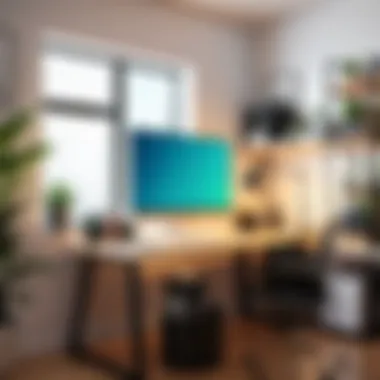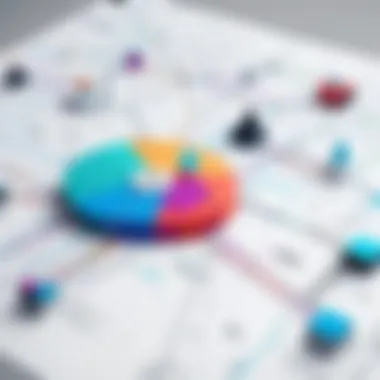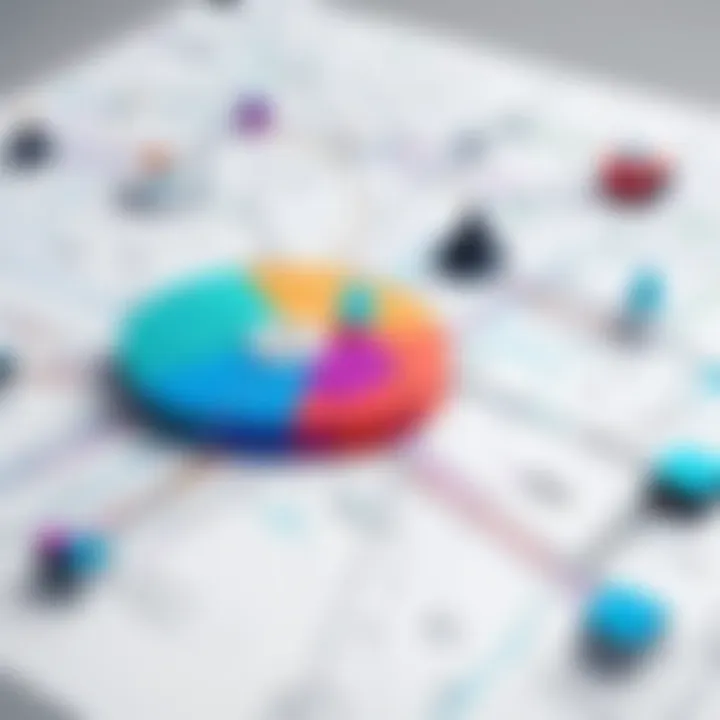Enhancing Creativity in Design Practices


Intro
Creativity in design is more than just combining colors and shapes; it's about thinking differently and embracing unique ideas. In an era where design demands are ever-increasing and evolving, the necessity to foster creativity has never been more imperative. From graphic design to architecture, the ability to innovate plays a crucial role in not only satisfying client needs but also standing out in an oversaturated market. This article dives deep into the intricate landscape of design creativity, exploring methodologies, psychological angles, and practical strategies to amplify creative output.
Design is steeped in culture, technology, and even psychology, making the act of creating a multifaceted endeavor. The quest to foster creativity entails understanding these elements and weaving them into a nurturing environment. Thus, it becomes vital to dissect the components that contribute to innovative design practices—whether it's harnessing the latest tech trends, understanding psychological resilience, or promoting collaboration amongst designers.
Throughout this article, we will tackle various aspects of creativity in design, equipping designers with actionable insights. By demystifying what fuels creativity, we can empower individuals to think outside the box, even when modern constraints seem weighty. Each section unfolds a layer of understanding, ultimately illustrating how we shape design creativity through awareness, tools, and techniques.
Understanding Creativity in Design
Understanding creativity within the context of design is akin to knowing the soil where a tree takes root. The health of that soil can determine how sturdy and fruitful the tree will ultimately become. In this article, we will delve into various aspects of creativity in design, emphasizing its significance and its impact on innovation.
The Concept of Creativity
Creativity, at its core, is not just about thinking outside the box; it’s about reinventing the box itself. It involves the ability to generate novel ideas, transform concepts, and intertwine them to forge something entirely unique. In the vast landscape of design, being creative is essential. Designers need to embark on a journey where ideas stem from imagination and flourish into practical solutions.
Creativity shapes how we interact with the world, fostering the design that resonates with audiences. Various factors contribute to the understanding of creativity, including individual perception, cultural background, and life experiences. Each designer brings a personal flavor to their work, making creativity a deeply individualized concept. Moreover, embracing creativity can lead to significant benefits, such as:
- Improved problem-solving capabilities
- Enhanced aesthetic appeal in designs
- Greater adaptability to market trends
- Increased potential for innovative breakthroughs
Creativity in the Context of Design
When we consider creativity specifically in design, it morphs into a structured yet fluid discipline. Designers are faced with challenges that require them to not only solve problems but also to anticipate user needs. This duality is what makes creativity in design a valuable asset.
In this digital age, where visuals dominate, the role of creativity becomes even more crucial. Good design speaks volumes without uttering a single word. It transforms functionalities into experiences, which in turn shape how users engage with a product or service. To break this down further, several components play a role in fostering creativity within design:
- User-centric approach: Understanding the audience and their needs can inspire inventive designs.
- Cultural awareness: Exposure to various cultures can provoke new perspectives that enrich design solutions.
- Emotional responsiveness: Good designs evoke feelings; the blend of functionality and emotion is essential in the creative process.
"Creativity is intelligence having fun" — Albert Einstein.
Psychological Foundations of Creativity
Understanding the psychological foundations of creativity is like peeling back the layers of an onion; each layer reveals a deeper insight about how our minds work when it comes to crafting innovative designs. Creativity isn’t merely a talent that some possess and others don’t. Instead, it springs from a complex web of cognitive and emotional processes that can be nurtured and developed. Recognizing these foundational aspects can greatly benefit designers, enabling them to harness their potential effectively.
Cognitive Processes Involved
At the heart of creativity are several cognitive processes that play a crucial role in launching the spark of innovation. When thinking creatively, individuals often engage in divergent thinking, which allows them to explore multiple possibilities and perspectives. This process contrasts sharply with convergent thinking, where the focus is on arriving at a single correct solution. Engaging in diverse thought patterns can lead to original ideas that break the mold of traditional design paradigms.
Here are some vital cognitive processes that underlie creativity:
- Associative Thinking: This involves making connections between seemingly unrelated concepts. By associating different ideas, designers can generate novel approaches to problems.
- Pattern Recognition: Skilled designers can see patterns where others see chaos, helping them to draw inspiration from the world around them.
- Visualization: The ability to imagine ideas in a spatial context allows designers to mentally prototype and iterate on their concepts before materializing them.
Understanding how these cognitive processes interact can empower designers to cultivate a creative mindset. For example, regular brainstorming sessions can stimulate associative thinking, while exercises in visualization can enhance spatial awareness.
The Role of Emotions
While cognitive processes are pivotal, it's essential not to overlook the emotional dimension that significantly influences creativity. Emotions can either serve as a catapult, launching creative thought, or act as a barrier, hindering the flow of ideas.
When designers feel enthusiastic and inspired, they are likely to produce more innovative and daring designs. Passionate emotions fuel exploration and risk-taking—an invaluable asset in a field governed by aesthetics and function. Conversely, feelings like anxiety or fear of judgment can create inner turmoil, leading to creative blockages.
To foster a positive emotional climate for creativity, designers might consider the following:
- Cultivating a Growth Mindset: Emphasizing learning over perfection lowers the stakes and encourages innovative risk-taking.
- Creating Space for Emotional Expression: Allowing designers to express their emotions—whether through discussions, art, or even movement—can free up cognitive space for new ideas.
As echoed by numerous studies, the link between creativity and emotional well-being cannot be ignored. A harmonious balance between thought and feeling enables designers to navigate the rocky terrain of creative exploration effectively.
"Creativity is intelligence having fun." – Albert Einstein
Environmental Influences on Creativity
Understanding the environmental aspects that foster creativity is crucial for designers wanting to put their best foot forward. The surroundings where ideas take shape can either ignite sparks of inspiration or snuff them out entirely. This section delves into the significant influences the environment has on the creative process, examining how both physical spaces and collaborative settings contribute to or hinder innovative thinking.
Impact of Physical Space
The layout and design of a workspace has a profound effect on creativity. Think about it: is a cluttered, dimly lit room more conducive to imaginative brainstorming than a bright, airy space filled with plants? Evidence suggests otherwise. An organized, engaging workspace can boost productivity and encourage original ideas.
- Natural Light: Studies show that exposure to natural light can elevate mood and cognitive function. Designers should aim to have areas bathed in sunlight or utilize lamps that mimic daylight. This simple adjustment can lead to a more energetic and inspired mindset.
- Color Psychology: Colors have a strong psychological impact. For instance, blue can cater to creativity whereas yellow ignites optimism. A smart way to foster creativity is to paint walls in soft, inviting hues or use artwork that inspires vibrancy.
- Flexible Design: Creativity flourishes in spaces that adapt to users’ needs. Go for movable furniture or areas that can easily transform from a collaborative zone to a quiet nook for focused work. Providing options lets individuals find their ideal creative flow.
In an environment that embraces the uniqueness of its occupants, ideas flourish like a garden in bloom.
Collaborative Environments
Collaboration plays a pivotal role in creative processes. Innovative ideas often stem from blending diverse perspectives. The magic happens when individuals from various backgrounds come together to brainstorm and refine concepts.
- Diverse Teams: Mixing different expertise and viewpoints can result in surprising solutions. Companies that champion diversity in their teams see enhanced creativity and a broader range of ideas. It’s like adding spice to a bland dish; it wakes up the palate.
- Workshops and Brainstorming Sessions: Facilitating interactive workshops can be a game changer. These sessions encourage open dialogue where all voices are valued, and it’s often here that the most original concepts come to life.
- Social Spaces: Incorporating areas designed for relaxation and social interaction proves beneficial. Casual conversations can trigger ignition for new ideas, often when least expected! A coffee break in a creatively designed lounge can lead to the next breakthrough.
"The best ideas often come from casual conversations, not formal meetings."
Techniques for Unleashing Creativity


Creativity is a muscle that needs constant exercise. Techniques for Unleashing Creativity play a crucial role in helping designers tap into their innovative potential. These techniques are not just a collection of random ideas but rather a framework that encourages free-flowing thought, idea generation, and exploration. In this section, we will delve into specific strategies that enable designers to break free from conventional constraints, fostering an environment ripe for creativity.
Divergent Thinking Strategies
Divergent thinking is all about generating multiple solutions to a single problem. It’s like brainstorming on steroids. This kind of thinking allows individuals to explore a variety of possibilities and look at challenges from different angles. The beauty of divergent thinking lies in its capacity to defy predictability.
One effective way to encourage divergent thinking is to create non-judgmental spaces where ideas can flow. Designers might host informal get-togethers or workshops where everyone can pitch ideas without fear of critique. Techniques such as free writing, where individuals write continuously for a set period, can also stimulate spontaneous ideas.
Besides, employing the six thinking hats method can guide users through different perspectives, encouraging them to view a problem through emotional, analytical, and creative lenses. This approach not only broadens the scope of solutions but also ensures someone isn’t stuck in a single mode of thinking.
Mind Mapping as a Tool
Mind mapping is a visual representation of ideas and concepts that aids in organization and exploration of thoughts. It’s like creating a spider web of ideas, where each strand leads to another new concept. This technique harnesses both the analytical and creative aspects of the brain, making connections that might not be immediate through linear thinking.
To implement mind mapping effectively, one might start with a central theme, perhaps a design project, and branch out into sub-themes. Each branch can represent different aspects, such as color palettes, materials, and inspiration sources. Some tools let you create these maps digitally. Tools like MindMeister and XMind enable teams to collaborate and edit in real time.
Mind mapping can make complex information simpler to grasp and stimulate associative thinking that leads to extraordinary ideas.
Incorporating Constraints
While it may seem counterintuitive, introducing constraints can act as a catalyst for creativity. Limitations force designers to think outside the box and find innovative solutions within specific parameters. This can involve setting time limits, budget caps, or defining strict guidelines for projects. Constraints can spark resourcefulness in unexpected ways.
An example could be a designer assigned to create a product for sustainable living but with a strict budget. This limitation can lead the designer to explore eco-friendly materials that are both affordable and innovative. Constraints often highlight areas where creativity can thrive, pushing boundaries and fostering original ideas.
Additionally, constraints encourage a clearer focus. With guidelines laid out, designers channel their creative energy effectively, honing in on solutions that might have otherwise gone unnoticed. Whether through local sourcing of materials due to budget or time, limitations can lead to the unexpected and, often, to brilliance.
These techniques provide practical and varied avenues for unleashing creativity in design. Engaging in divergent thinking, utilizing mind maps, and embracing constraints offer valuable methods to stimulate innovation, all the while empowering designers to think beyond ordinary ideas.
The Importance of Inspiration
In the journey of design, inspiration acts as the fuel that ignites creativity. It's not just a fancy word thrown around in brainstorming meetings; it’s a core component that shapes ideas and drives innovation. When designers tap into their wells of inspiration, they often find new ways to approach problems, leading to breakthroughs that are both fresh and impactful. A mind filled with inspiration can see beyond the obvious, leading to creative solutions that might not otherwise emerge.
Furthermore, the act of gathering inspiration creates a framework within which designers can contextualize their work. This context is vital, as it molds how ideas manifest, ensuring they resonate with intended audiences. It’s crucial to understand that the sources of inspiration are diverse, ranging from the trivial to the profound, each contributing differently to the designer’s output.
Observing the World Around You
Details coalesce in everyday life, waiting to be noticed. The desire to create should come hand in hand with the ability to observe. Taking time to notice the lines in a building, the play of shadows on the sidewalk, or the contrasting colors in a busy market can spark that creative engine. Designers who integrate observations from the world around them into their work often find themselves creating designs that resonate more profoundly with users.
- Nature as a Muse: Nature’s patterns and textures—be it the symmetry of leaves or the fluidity of water—offer lessons in balance and harmony.
- Urban Inspirations: Cityscapes provide a palette of colors and shapes that inspire everything from product design to user interfaces.
- Cultural Interactions: Observing how people interact with their environment can lead to insights that improve functionality and aesthetic appeal.
It's about seeing the extraordinary in the ordinary, which can lead to innovations that seem intuitive yet are strikingly original.
Seeking Cultural Influences
Culture plays an undeniable role in shaping creativity. By delving into different cultures, designers expand their horizons, uncovering new ideas, aesthetics, and ways of thinking. Such exploration is not just about appreciating art or fashion from other places; it involves a deeper understanding of how cultural narratives inform design principles.
Incorporating cultural influences can serve various purposes:
- Diversity of Thought: Engaging with diverse perspectives helps combat design homogeneity. When creators embrace different cultural elements, they create work that speaks to a broader audience.
- Historical Context: Understanding past design movements from various cultures gives insight into current trends and future possibilities.
- Symbolism and Meaning: Many cultures have rich symbolism that can enhance a design's narrative, making it more meaningful.
By seeking out these influences, designers can cultivate a richer, more nuanced approach to their creation process. It becomes less about what’s trendy and more about crafting designs that reflect a global tapestry of ideas.
"Inspiration is everywhere, but it’s the perceptive eye that transforms it into something unique."
In summary, inspiration is the bedrock upon which creativity stands. By honing observational skills and engaging with cultural influences, designers can create work that is not only innovative but also deeply resonant with the modern world.
The Role of Technology in Design Creativity
In today's fast-paced world, technology has become an integral part of the design process. Designers no longer work in isolation; instead, they are part of a dynamic ecosystem where collaborative tools and software can enhance the creative output. Understanding the role of technology in design creativity is crucial for anyone looking to make waves in the industry.
Technology not only streamlines workflows but also fosters innovation by providing designers with powerful tools to visualize their ideas. From brainstorming to prototyping, technology enhances every step of the design journey. This section delves into specific elements, benefits, and considerations regarding the role of technology in design creativity.
Software Tools for Designers
When it comes to design, software tools are akin to a painter's palette. These applications help turn abstract ideas into tangible outcomes. Several powerful software solutions exist that cater to various aspects of design, from graphic design to user interface development. Among the leaders are programs such as Adobe Creative Cloud, Sketch, and Figma.
- Adobe Creative Cloud offers a suite of applications, including Photoshop and Illustrator, perfect for graphic design and photo editing. This versatility allows designers to experiment, combining different elements with ease.
- Figma stands out for its collaborative features, allowing real-time feedback among multiple stakeholders, which is vital in today's collaborative work environment.
- Sketch, predominantly used for UI/UX design, has built a strong community around plugins and integrations that extend its abilities.
Utilizing these tools, designers can maintain a fluid workflow, rapidly iterate on ideas, and produce high-quality work efficiently.
Online Collaboration Platforms
In a world where remote work has become the new normal, online collaboration platforms have risen to prominence. These tools serve as virtual studios, enabling designers to brainstorm and create collectively, regardless of geographical barriers. Among the notable platforms are Miro, Slack, and Trello.
- Miro acts like a digital whiteboard, suitable for mapping out ideas and brainstorming sessions visually. Teams can simultaneously add notes, images, and drawings, making it easier to see concepts take shape in real-time.
- Slack enhances communication among team members, allowing for quick exchanges of ideas, files, and feedback without the email back-and-forth.
- Trello offers a visual approach to project management, allowing teams to track progress, set deadlines, and assign tasks efficiently.
All these platforms create a conducive environment for creativity by promoting interaction and reducing misunderstandings.
"Technology does not replace creativity, but rather fuels it, pushing the boundaries of what designers can achieve."
In summary, the relationship between technology and design creativity is a symbiotic one. Tools and platforms not only enhance productivity but also broaden the horizons of what is possible in design. Engaging with the right software and collaboration tools enables designers to innovate and evolve continuously.


Collaboration and Ideation
Collaboration and ideation are crucial elements in the realm of design, acting as catalysts for creativity. In a landscape where multifaceted problems loom large, harnessing the collective wisdom of a team can lead to innovative solutions that one individual might miss. When diverse minds convene, it’s not just a meeting of brains; it's a melting pot of experiences, backgrounds, and perspectives that can give rise to groundbreaking ideas.
The benefits of collaboration are manifold. Working within a team allows for immediate feedback, mitigates the risk of 'groupthink', and creates an environment ripe for experimentation.
When designers collaborate, they don't just bounce ideas off each other; they build off the initial sparks of creativity. One person's half-baked notion can ignite a wildfire of inventive thinking. This interplay can often lead to unexpected and valuable outcomes, which a solitary endeavor may overlook.
Considerations for effective collaboration include establishing a clear goal from the outset, clarifying roles and responsibilities to prevent confusion, and ensuring there is a culture of respect and openness. With these elements in place, teams can flourish creatively.
"Collaboration often leads us where we couldn’t have gone on our own.”
Working with Diverse Perspectives
Diversity in design is more than just a buzzword; it's a fundamental principle that can greatly enrich the creative process. When individuals with different backgrounds, expertise, and insights come together, they create a richer tapestry of ideas. This directly influences how challenges are viewed and tackled.
Each member can offer a unique set of lenses through which to analyze a problem. For instance, a designer with a background in psychology might approach user experience in ways that a purely technical person wouldn't consider. By harnessing this diversity, teams can enhance their problem-solving capabilities.
Here are a few key ways that working with diverse perspectives can benefit the design process:
- Broader Ideation: More viewpoints equate to a greater variety of ideas.
- Enhanced Creativity: Unique backgrounds lead to innovative solutions.
- Increased Adaptability: A team that views problems differently can pivot more effectively when faced with challenges.
Facilitating Effective Workshops
Workshops play an indispensable role in the collaboration process. These focused sessions can serve as incubators for creativity, harnessing the collective energies of participants in a structured yet spontaneous environment. For a workshop to be productive, several elements should be carefully considered.
First and foremost, preparation is key. Setting an agenda that outlines specific outcomes, while allowing for flexibility, can help guide participants while giving them the freedom to explore ideas. The environment should also encourage openness—ensure that everyone feels comfortable sharing their thoughts without fear of ridicule.
Here are some strategies to facilitate effective workshops:
- Icebreakers: Start with activities designed to ease tension and stimulate engagement.
- Idea Generation Techniques: Use tools like brainstorming or the 'crazy eights' method to encourage rapid idea production.
- Group Discussion: Facilitate open dialogue to refine and expand on the ideas presented.
- Feedback Sessions: Don’t just create; iterate. Gather insights on ideas to develop them further.
By fostering an atmosphere where all these elements converge effectively, workshops can catalyze extraordinary ideas that redefine design paradigms.
Feedback and Iterative Design
In the realm of design, feedback and iterative design are cornerstones that can elevate a project from ordinary to extraordinary. Feedback is not merely a courtesy; it is essential for refining ideas and making informed decisions. It creates a dialogue between the designer and the audience, be they clients, users, or peers. The iterative process, in tandem with feedback, allows for continuous improvement. Each iteration brings a chance to reassess, realign, and refine one’s work based on valuable insights garnered from others.
One critical aspect of feedback in design is its capacity to unveil perspectives that the designer might overlook. It encourages a broader understanding and pushes boundaries. Constructive criticism functions as a mirror reflecting our blind spots and weaknesses. This process encourages designers to step back and consider how their work resonates with an audience, thereby enhancing the relevance and functionality of the final product.
What truly singes the imagination is the iterative design process. By routinely revisiting and relaying creative efforts, designers can experiment without the fear of making mistakes. Each design version can be viewed not as a final product but as a stepping stone in an adventure of artistic exploration. This mindset shifts the approach from a fixed endpoint to an evolving journey of creativity.
"Feedback is the breakfast of champions."
— Ken Blanchard
When integrating feedback and iteration, consider several key elements:
- Diverse Input: Seek opinions from different stakeholders. This could involve fellow designers, users, or even influencers in the field. Their diverse views help paint a fuller picture.
- Regular Checkpoints: Establish recurring opportunities to review progress. This could be weekly meetings or milestone presentations to stakeholders for timely insights.
- Documentation of Changes: Keeping a record of feedback received and design changes made fosters transparency. It can also guide future projects and potentially reveal patterns in feedback that lead to a richer design philosophy.
From a practical standpoint, in agile methodologies, feedback loops are commonplace. Designers continuously improve products through small, incremental changes that are validated by user input. The moment a designer embraces feedback, they allow their creativity to flourish.
Ultimately, the objective is not only to complete a design but to cultivate a piece that resonates deeply with its intended audience. This intertwining of feedback and iterative processes empowers designers to be more innovative and introspective, ensuring every design decision contributes toward a more refined final offering.
The Value of Constructive Criticism
Constructive criticism carries immense value in the design process. It isn’t about tearing down one’s work; it’s about lifting it to new heights. When one receives critical feedback, the aim should be to use it to refine their ideas rather than to feel disheartened.
There is a unique strength found in various critiques, as they shed light on how different audiences perceive designs. It is a golden opportunity to understand the needs, preferences, or even the pain points of the target audience. Design is ultimately about solving problems, and constructive criticism serves as a compass that points designers toward practical improvements.
Engaging with critics actively can be an enlightening experience. Designers often find that when criticism is well-articulated, it sparks new ideas and inspiration. Rather than pushing back against feedback, welcoming it can create a rich environment for creative exploration. It cultivates a culture where experimentation is encouraged, and ideas can be tested freely.
Iterative Prototyping Techniques
The approach of iterative prototyping involves creating a series of prototypes to incrementally refine designs. This technique is driven by the idea that tangible progress can spur creativity and innovative solutions. Prototyping serves a dual purpose: it tests ideas and communicates them effectively.
Here are some practical techniques involved in iterative prototyping:
- Low-Fidelity Prototypes: Start with sketches or simple paper models. These are inexpensive to create and allow for quick adjustments based on initial feedback.
- Digital Mock-ups: Use software like Adobe XD or Sketch to create interactive models that represent the design more accurately. This gives users a feel of the experience without committing to a final product.
- User Testing: Always involve users early in the design. Gather feedback on the prototypes, allowing you to make significant changes before proceeding to higher-fidelity versions.
- Refinement: After each round of feedback, refine the prototype accordingly and repeat the testing. This creates a cycle of continuous improvement.
Implementing these techniques fosters a more dynamic and engaging design process. The key is to embrace the flaws and challenges of each prototype, viewing them as stepping stones to a more polished final design.
Overcoming Creative Blockages
Identifying Sources of Blockage
Before you can tackle a blockage, you need to pinpoint it. Some common sources might include:
- Mental fatigue: Overworking can drain resources and curb innovation.
- Fear of criticism: Worrying too much about what others may say can create a paralyzing effect.
- Environmental distractions: A cluttered space can lead to a cluttered mind.
- Lack of inspiration: Sometimes, all you need is a fresh perspective or a new stimulus.
To figure out the blockage, take a moment and ask yourself a few questions. What anxiety keeps creeping in? Is my workspace cramped and uninspiring? Do I feel like my last few ideas didn't meet the mark? Reflecting on these facets illuminates the path ahead.


Strategies for Resolution
Once the sources are identified, it's time to roll up your sleeves and start implementing some effective strategies:
- Take a step back: Sometimes, all it takes is a brief change of scenery. A walk might clear your head and help you see things from a different angle.
- Set small goals: When you're stuck, the mountain can look daunting. Break down tasks into smaller, manageable bites to regain a sense of achievement.
- Embrace imperfection: Perfection is the enemy of progress. Allow yourself to create without fear. Always remember, the first draft is meant to be a sketch.
- Engage in mindfulness: Techniques like meditation or simple breathing exercises can be tremendously effective in resetting your mental state. They ground you and may open up creative channels.
- Discuss with peers: Talking to colleagues can provide alternative angles on the same issue. A chat can spark new light where there was once shadow.
"Creativity involves breaking out of established patterns in order to look at things in a different way."
In the quest for creativity, facing and overcoming blockages isn't merely a hurdle—it’s a significant part of the journey. By pinpointing root causes and employing targeted strategies, designers empower themselves to overcome hurdles and foster unique, innovative ideas.
Mindfulness and Creativity
The Influence of Mindfulness Practices
Mindfulness practices, such as meditation and focused breathing, provide a pathway to clarity. When designers incorporate these practices into their routines, they tend to experience a noticeable shift in their thinking. Instead of rushing through ideas, they learn to observe them, letting them marinate for a while. This pause can be transformative.
Research indicates that engaging in mindfulness can lead to improved focus and reduced anxiety, both essential for creative work. For example, when a designer sits in silence to meditate, the world around them fades away. They may find themselves immersed in their thoughts, allowing ideas to percolate rather than explode under pressure.
- Benefits of Mindfulness in Design:
- Enhances focus and attention: It helps in isolating distractions that often cloud creative judgment.
- Encourages a non-judgmental approach: When designs are evaluated without immediate criticism, original thoughts have room to emerge.
- Boosts resilience: Mindfulness cultivates a sense of calm, enabling designers to tackle challenges with a fresh perspective.
These practices resonate deeply within design circles, paving the way for a more holistic approach to creativity.
Stress Reduction Techniques
Stress is often the nemesis of creativity. In the high-stakes world of design, where competition can feel daunting, stress can stifle our best ideas before they even get off the ground. Yet, exploring stress reduction techniques can empower designers to break free from this cycle.
- Deep Breathing: Taking a moment to breathe deeply can reset the mind. Simply inhaling for four counts, holding for four, and exhaling for four can provide a quick mental reset.
- Nature Walks: Stepping outside can foster a new perspective. Nature has a unique ability to inspire creativity and reduce feelings of overwhelm. Just a short walk amidst greenery can rejuvenate the mind and spark ideas.
- Journaling: Writing down thoughts, worries, or even doodling can release pent-up tension. It’s a way to declutter the mind, opening pathways for creativity to flourish.
Incorporating these techniques into everyday practice doesn’t require a complete overhaul of one’s routine. Often, small tweaks—a few deep breaths before brainstorming or a five-minute nature walk during a break—can yield significant impacts. By addressing stress proactively, designers can ensure their creative spaces are vibrant rather than stifled.
"Mindfulness in design isn’t just about being still; it’s about heightening one’s awareness to the unfolding of ideas."
Incorporating mindfulness into one’s design practice not only serves as a tool for stress reduction but also cultivates a fertile ground for creativity to thrive. Finding ways to integrate these practices into daily routines is less about sacrificing time and more about enriching the design experience itself.
As designers navigate the complexities of their work, understanding and applying these mindfulness principles can vastly improve not only their creativity but also their overall design journey.
Long-Term Strategies for Creative Growth
In the realm of design, fostering creativity isn't just a fleeting spark; it's about nurturing a fire that can blaze for years to come. Long-term strategies for creative growth offer designers a pathway to harness their ingenuity consistently. These strategies hinge on mindful practices that keep the creative juices flowing even in the face of challenges. As the design industry evolves, embracing these long-term strategies ensures that professionals not only survive but thrive in a highly competitive landscape.
Continuous Learning and Development
Design is an ever-changing field, influenced by technological advancements and cultural shifts. Continuous learning is not merely an option—it's a necessity. Designers need to commit to expanding their skills and knowledge over time, keeping pace with the latest trends, tools, and methodologies. By re-engaging with the educational ecosystem, designers can employ various techniques to cultivate their growth:
- Enroll in Workshops and Online Courses: Taking part in workshops allows for hands-on experience. Online courses can be flexible, allowing learning at one’s own pace.
- Attend Industry Conferences: Events provide opportunities to network and gain insights from fellow professionals and innovators.
- Read Widely: Keeping up with design journals, tech blogs, and even literature outside of design can provide fresh perspectives.
This ongoing commitment to learning results in a more nuanced understanding of design concepts, leading to improved output and better problem-solving skills.
Building a Personal Design Philosophy
Every designer has a unique lens through which they view the world. Building a personal design philosophy helps to solidify this perspective. It acts as a guide in the decision-making process and gives depth to one's work. To cultivate this philosophy, consider these steps:
- Reflect on Personal Inspirations: Identify what moves you—be it artists, movements, or experiences. Pinpointing these elements can guide your creative journey.
- Articulate Core Values: What principles do you adhere to in your work? Defining these can ensure your output remains consistent and authentic.
- Experiment and Iterate: Allow yourself the freedom to explore different styles and ideas. Each experiment can inform and refine your philosophy further.
A clear design philosophy not only enhances creativity but also aligns your projects with your personal ethos, making your designs not just functional but also meaningful.
"Creativity is intelligence having fun." – Albert Einstein
Combining continuous learning with a solidified design philosophy is like blending colors on a palette; each aspect complements and enhances the other. Designers who apply these long-term strategies will find themselves not just as participants but as leaders in the design conversation, equipped to adapt and innovate as the landscape shifts.
Ending
Creativity in design is not just a fleeting concept; it’s an essential component that influences how we interact and engage with the world around us. The discussion presented throughout this article highlights that fostering creativity isn't merely about individual inspiration but involves creating an ecosystem that encourages innovative thought.
The process of fostering creativity involves various strategies – from understanding psychological foundations to recognizing environmental influences. Tools and strategies from mind mapping to collaborative workshops provide practical methods to generate fresh ideas.
Benefits of Emphasizing Creativity:
- Enhanced Problem-Solving: A creative mindset can tackle challenges from diverse angles, leading to innovative solutions.
- Adaptive Thinking: In a market that constantly evolves, adaptability is crucial. Creativity fosters a mindset that embraces change rather than fears it.
- Collaboration Synergies: Encouraging creative practices can significantly improve team dynamics, as diverse ideas come together to form more robust design propositions.
- Personal Fulfillment: Engaging in creative activities can lead to personal satisfaction and joy in one’s work.
However, it's important to remember that fostering creativity isn't just about implementing techniques or tools; it also involves creating a supportive atmosphere that nurtures ideas without the fear of failure. Appreciate the messy process of creativity where numerous rough drafts, failed experiments, and brainstorming sessions can eventually lead to breakthrough innovations.
"Creativity is intelligence having fun." — Albert Einstein
By merging the insights shared in this article with ongoing personal development, designers can continually unearth their potential and enhance the quality of their work. This is not just a goal—it's a journey that involves exploration and a commitment to pushing boundaries. In today’s dynamically changing design landscape, understanding this is more crucial than ever.
Recap of Key Points
- Creativity is a multi-dimensional concept that intertwines cognitive processes, emotional factors, and environmental influences.
- Techniques such as mind mapping and iterative design play significant roles in augmenting creative output.
- A supportive environment, alongside collaboration and constructive feedback, fosters innovative thinking.
- Overcoming creative blockages through mindful practices contributes to sustained creative growth.
Call to Action for Designers
- Engage in Continuous Learning: Stay updated with the latest design trends and tools. Consider enrolling in online workshops or courses that inspire you to think differently.
- Create a Collaborative Space: If you're working with a team, design your workspace to encourage collaboration. Whiteboards, post-it notes, and open discussions can spark new ideas.
- Practice Mindfulness: Integrate mindfulness techniques into your routine to clear mental clutter. Simple practices like meditation or even a few moments of deep breathing can boost your creativity.
- Ideate Freely: Dedicate time for brainstorming sessions. Embrace wild ideas without restrictions, allowing space for innovation.
- Showcase Your Work: Share your designs within a community, whether online on platforms like Behance or through local design events. Feedback can be invaluable for growth.
Ultimately, let curiosity lead the way. Ask questions, experiment boldly, and remember that in the realm of design, the only limits that exist are the ones we impose on ourselves.







